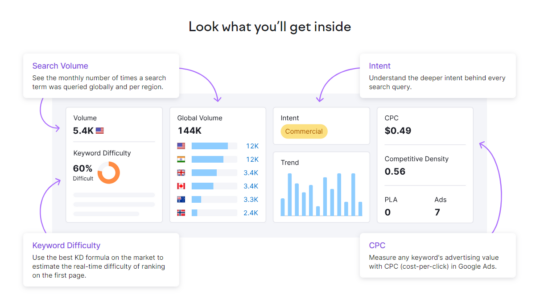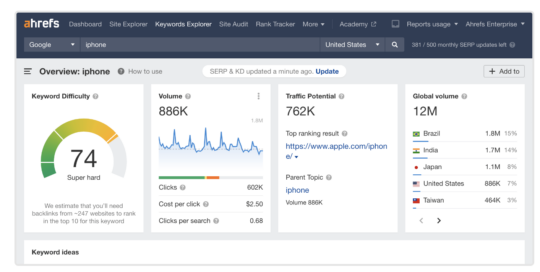A website's success is determined by its traffic! In plain English, traffic refers to how many visitors visit your site. Nevertheless, due to Google's changing algorithms, generating organic traffic is no longer a cakewalk.
A keyword list is crucial to ranking well in search engines. Content should be top-notch and relevant, and keywords should be easy to find.
Therefore, picking keywords randomly is not an option; precise measurement of keyword difficulty is essential to the overall SEO leap. We're here with this quick guide that discusses everything about the context.
No more waiting! Let's get straight to the point!
What is Keyword Difficulty in SEO?
Keyword difficulty is a metric to evaluate the difficulty of ranking for a specific keyword in search engines. The range is calculated from 1 (low competition) to 100 (high competition).
For example, "credit cards" have a high difficulty score and thus are challenging to outrank for relevant search results from top-ranking websites. The keyword difficulty score usually depends on certain factors like domain authority, page authority, and Quality of content.
Why is Keyword Difficulty Important?
Here are specific reasons for the importance of keyword difficulty:
Strategic Decisions
You can make strategic decisions to improve your search rankings. This is only possible when you analyze the keywords correctly and gauge the competition in SERPs.
Help Content Teams
Focusing on keywords that can rank rather than overly competitive keywords helps optimize content that stands out and ranks better.
Worker Smarter with Limited Resources
When incorporated as a part of the strategy, KD lets you work smarter, not harder. With this, you get a large amount of data to understand opportunities swiftly.
What are the Factors that Influence It?
Domain Authority (DA): Websites with higher DA are known for good content quality, backlinks, authority, age, and more. If they use a particular keyword, it becomes difficult to rank for, making it competitive.
Page Authority (PA): The authority of a particular page also plays a crucial role. Pages with good content, quality backlinks, and user experience are difficult to rank.
Backlinks: Backlinks help improve a website's DA and PA. However, some pages target keywords with a high number of backlinks, and again, the difficulty score becomes higher.
User Engagement: Certain vital metrics such as click-through rates (CTR), bounce rate, and more have a significant impact on the keyword difficulty as
How to Measure Keyword Difficulty Score?
Certain tools are available that let you calculate the score. Each offers insights you can utilize to get the desired results. The tools consider different factors such as DA, PA, backlinks, and content quality.
Some of the popular tools are SEMrush, and Ahrefs.
SEMrush:
The KD metrics are in the keyword overview section of SEMrush. To use them, enter the keywords into the tool, and you will see the results.
Here’s the image for reference:
Ahrefs
When considering Ahrefs, visit the keyword difficulty checker under the free SEO tools section. Simply enter the keyword in the box, and you will understand the difficulty level. The score is labeled clearly, along with descriptive text for reference.
Going with the Manual Analysis
Alternatively, Manual Analysis: For a more personalized approach, manual analysis involves evaluating the top-ranking pages for a keyword. Factors to consider include:
- Content Quality: Analyze the content's depth, relevance, and comprehensiveness.
- Backlink Profile: Check the number and Quality of backlinks pointing to the top-ranking pages.
- Domain and Page Authority: Use tools like Moz's Open Site Explorer to assess DA and PA.
- On-Page SEO: Review the use of keywords, meta tags, and overall site structure.
Good Keyword Difficulty: The Meaning
A good keyword difficulty score depends on your SEO strategy. This is tricky, but here's where you tend to lose. One of the ideal ways is to collect all the relevant information, including competition, scores, content quality, and more, to make the right decisions.
Low Quality (0-30): These are the keywords you can rank for quickly. They have low search volumes, but they are ideal for new websites that want to rise to the top.
Medium Quality (31-60): These keywords have moderate competitivity and maintain a good balance between search volume and competition.
High Quality (61-100): These are the most competitive, tough keywords to rank for. Generally, the keywords have a high volume and are from authoritative websites. Targeting high-quality keywords may require more time, resources, and a robust online presence in the market.
Final Thoughts
If you're an intelligent SEO marketer or a newbie, understanding the importance of keyword difficulty is a good use for learning. Mainly, it's one of the best ways to improve your organic ranking and traffic.
By maintaining the right balance of keywords, you can outperform the competition. The roadmap to website success starts here!
Recommended For You:
Top SEO audit tools in 2024 to Check out
Stay Ahead of the Game: All About Tracking SEO Metrics in 2023






